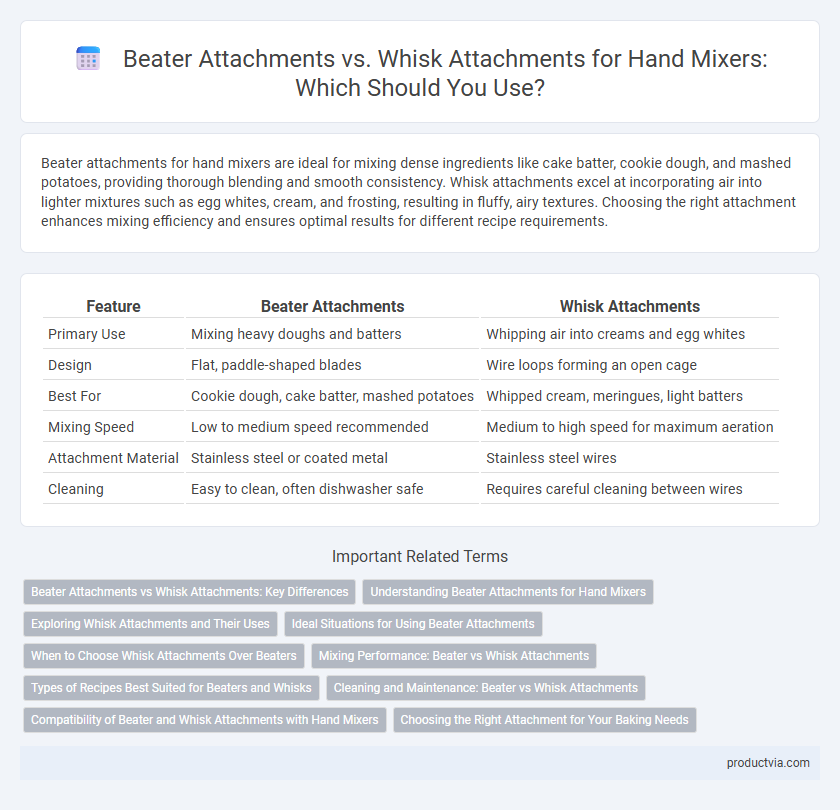Beater attachments for hand mixers are ideal for mixing dense ingredients like cake batter, cookie dough, and mashed potatoes, providing thorough blending and smooth consistency. Whisk attachments excel at incorporating air into lighter mixtures such as egg whites, cream, and frosting, resulting in fluffy, airy textures. Choosing the right attachment enhances mixing efficiency and ensures optimal results for different recipe requirements.
Table of Comparison
| Feature | Beater Attachments | Whisk Attachments |
|---|---|---|
| Primary Use | Mixing heavy doughs and batters | Whipping air into creams and egg whites |
| Design | Flat, paddle-shaped blades | Wire loops forming an open cage |
| Best For | Cookie dough, cake batter, mashed potatoes | Whipped cream, meringues, light batters |
| Mixing Speed | Low to medium speed recommended | Medium to high speed for maximum aeration |
| Attachment Material | Stainless steel or coated metal | Stainless steel wires |
| Cleaning | Easy to clean, often dishwasher safe | Requires careful cleaning between wires |
Beater Attachments vs Whisk Attachments: Key Differences
Beater attachments for hand mixers feature flat, paddle-like shapes ideal for mixing dense batters and doughs, ensuring thorough blending without over-aeration. Whisk attachments are designed with multiple thin wires to incorporate air efficiently, making them perfect for whipping cream, egg whites, and light mixtures. Understanding these key differences helps optimize baking results by selecting the appropriate tool for specific mixing tasks.
Understanding Beater Attachments for Hand Mixers
Beater attachments for hand mixers are designed for mixing medium to heavy batters such as cookie dough or cake mix, providing thorough blending and aeration. These attachments typically feature flat, paddle-shaped blades that effectively incorporate ingredients without overworking the batter, resulting in optimal texture and consistency. Unlike whisk attachments, beaters prioritize combining dense mixtures while maintaining a smooth blend essential for baking applications.
Exploring Whisk Attachments and Their Uses
Whisk attachments for hand mixers are specifically designed to incorporate air into mixtures, making them ideal for whipping cream, beating egg whites, and creating light, fluffy textures. These attachments usually have multiple thin wires arranged in a balloon shape, optimizing aeration and volume for meringues, mousse, and whipped toppings. Their design contrasts with beater attachments, which are better suited for mixing denser batters and doughs where aeration is less critical.
Ideal Situations for Using Beater Attachments
Beater attachments for hand mixers excel in tasks like mixing cake batter, cookie dough, and mashed potatoes, where thorough blending and consistent texture are essential. They provide strong agitation, making them ideal for combining heavier ingredients without over-aerating the mixture. Using beaters ensures smooth, uniform results in dense or thick preparations that require solid incorporation.
When to Choose Whisk Attachments Over Beaters
Whisk attachments are ideal for incorporating air into mixtures, making them perfect for whipping cream, beating egg whites, and preparing meringues. Their wire design allows for faster aeration and lighter textures compared to the denser mixing achieved by beater attachments. Choose whisks when your recipe requires fluffy, airy consistency rather than thorough blending or heavy mixing.
Mixing Performance: Beater vs Whisk Attachments
Beater attachments excel in mixing heavy ingredients like cookie dough and cake batter, providing thorough blending and consistent texture. Whisk attachments perform best with light, aerated mixtures such as egg whites and cream, incorporating air efficiently for fluffy results. Choosing the right attachment enhances mixing performance by matching the tool's design to the specific consistency and ingredient type.
Types of Recipes Best Suited for Beaters and Whisks
Beater attachments excel in mixing heavy batters, cookie dough, and mashed potatoes due to their sturdy design that thoroughly combines dense ingredients. Whisk attachments are ideal for whipping cream, egg whites, and light meringues, creating airy textures with rapid aeration. Selecting the appropriate attachment ensures optimal mixing performance and desired recipe consistency.
Cleaning and Maintenance: Beater vs Whisk Attachments
Beater attachments typically have a simpler design with fewer crevices, making them easier to clean and less prone to food residue buildup compared to whisk attachments. Whisk attachments, often featuring multiple thin wires, require more thorough cleaning to remove trapped ingredients and may need special brushes to maintain hygiene effectively. Regular maintenance, including immediate washing and drying, helps prolong the lifespan of both types but is particularly crucial for whisks to prevent rust and ensure optimal performance.
Compatibility of Beater and Whisk Attachments with Hand Mixers
Beater and whisk attachments for hand mixers must match the specific model and brand to ensure proper fit and function, as compatibility varies widely across manufacturers. Beaters are designed for heavier mixing tasks like batter and dough, requiring sturdier connections, while whisks are often lighter and intended for aeration, demanding precise attachment mechanisms. Verifying attachment compatibility through manufacturer guidelines or product descriptions helps maintain optimal performance and prevents damage to the mixer or accessories.
Choosing the Right Attachment for Your Baking Needs
Beater attachments for hand mixers excel at mixing heavy doughs and batters, providing thorough blending for cookies and cakes. Whisk attachments are designed to incorporate air rapidly, ideal for whipping cream, egg whites, and creating light, fluffy mixtures. Selecting the appropriate attachment depends on the texture and consistency required for your specific baking recipe.
Beater attachments vs Whisk attachments for hand mixer Infographic

 productvia.com
productvia.com